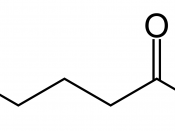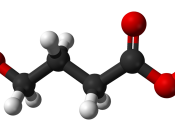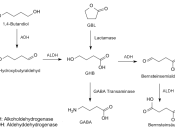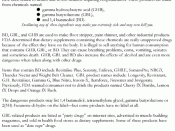"Psychological disorders related to designer drugs" is a very detailed orientated book. It contains information about the different aspects of drug use, including what are designer drugs and how their users are affected. Each chapter goes over important issues pertaining to designer drugs, starting with the history of the drugs and ending with current treatment options. In every chapter there are detailed accounts from previous users, or studies and opinions from various medical agencies.
The first chapter deals with identifying designer drugs. Designer drugs are any drugs that were created synthetically to mimic the effects of other medications or of drugs that came from natural resources. The reason they are called designer drugs is because they are specially designed and modified by the people who make them. The drugs are usually much stronger than their "natural" counterparts and are much more addictive. According to the United States government, Ecstasy, methamphetamine, Phencyclidine, Meperidine, and Gamma-Hydroxybutyric Acid are all classified as designer drugs.
Designer drugs started coming into the market in the 1960s and 1970s in response to the government clampdown on drugs like heroin and cocaine. The labs they are created in have been found in mountain cabins, warehouses, and even neighborhood schools. The problem with these labs is that the people who make the drugs usually have no knowledge of chemistry and are more concerned with making money than with the user's safety.
People have been using drugs for thousands of years. Use of narcotics made from plants dates back as far as 5000 B.C., when the juice of the poppy plant was cultivated to produce opium in Mesopotamia. The federal government began imposing restrictions on drugs in the early part of the 20th century. This was in response to the large number of civil war soldiers who had become hopelessly addicted to morphine after the war. The general attitude about drug use changed and even alcohol, the most socially accepted drug, was banned for a fourteen-year period. This attitude did not last forever. In the 1960s drug use skyrocketed in the United States. The predecessor to the DEA, the Bureau of Drug Abuse Control was created in 1966 to help control stimulants and crackdown on drug use. It was during this period that drugs began being made in underground laboratories to be sold on the street. The Controlled Substance Act of 1970 is what brought about the beginning of designer drugs. The act made possession of an illegal drug a misdemeanor and intent to sell it a felony. This caused many chemists to seek loopholes in the system by making their drugs different enough to not be considered illegal but still potent enough to produce the desired effects.
The use of designer drugs can affect a person in very different ways. Methamphetamine use can produce an intense rush that lasts anywhere from 5 minutes to a day, depending on how it is taken and how much is used. Long-term use can cause "stimulant psychosis" which completely alters the user's personality. Methamphetamine use can induce panic or psychosis and can lead to suicide or violence. Ecstasy users feel energetic and at peace when taking the drug. The drug heightens the five senses and gives the user an intense feeling of pleasure. Use of Ecstasy causes serious long-term consequences. The drug depletes the chemical serotonin, which affects mood, thinking processes, aggressive behavior, and sensitivity to pain. If the brain can't compensate for the changes caused by the drug, the long-term effects could include increased aggression, severe depression and even suicide. Phencyclidine can be a totally unpredictable drug. For some users it acts as a stimulant, for others it's a hallucinogen that causes them to have out-of-body experiences. There is not much known about PCP's long-term effects. One of the most serious effects is a disorder called schizophrenia. This mental disease causes the person to lose touch with reality, change their personality, and makes them unable to function in everyday life. Gamma-Hydroxybutyric Acid lowers social inhibitions, similar to alcohol. The problem with GHB is determining whether you are taking a small or a large dose. A dose may appear to be small but may be highly concentrated and produce undesired effects. These effects include nausea, grogginess, delusions and even liver failure. It is a very dangerous drug because of its unpredictability and immeasurable level of purity.
Society's views on drug use have changed dramatically. Many used to feel that drugs were acceptable and not a problem to the population at large. Today there are many organizations with the goal of a drug-free America. Studies throughout the years have proven the dangerous effects of illegal drugs and the deaths that are attributed to them. People are beginning to change their perspective on the issue and realize that drugs are an ever-growing problem. There are treatment centers in every major city in the United States and the number is growing worldwide. Society is finally starting to see drug use for what it really is, a problem.
Critique I have a high opinion of this book. Considering the subject matter and the way it was presented, I feel that this was a very well thought out book. It is primarily written for young adults and is on a level that is easy to understand. This book is part of a series dedicated to the field of psychology and psychological disorders. The editor of the book is president of Harvard University Medical School and C.E.O. of the American Psychiatric Press. This makes it easier for me to believe the information inside because I know that it is from a credible source.
I liked the way that this book was set up. It was not just another research article or medical journal essay. It was set up to keep my attention and to inform as well. Each chapter contains pictures pertaining to the subject matter and is full of interesting anecdotes from former users and medical professionals. I found the information inside to be pretty well up to date except for the street names for many of the different drugs. I realize that these names are the ones that the establishment has come to know and I am sure that they only pertain to their part of the country.
The format of the book is laid out in an easy to follow sequence. The first couple of chapters deal with identifying the drugs and giving you some history about them. I found this section of the book to be the most interesting because it went into detail about how and why these drugs were produced. I also appreciated the overview because it helped provide background information as well as set the pace for the rest of the book.
The next two chapters in the book were "Why do teens use drugs"? and "How are users affected"?. These chapters help you to understand the mindset of someone who is going to use PCP as well as the consequences of it. I found this part of the book to be very detailed but it lacked realism in some of the findings. This section included statements that I believe were highly unlikely and definitely not the actions of the majority. I found this part of the book to contain cliché opinions about drug users and drug abuse. Much of the information in this section was common knowledge. I did not find the material in this section to be new or revolutionary.
The last two chapters in the book had to deal with the impact of drug use on society and the current treatment options. I had hoped that this section would contain some interesting anecdotes but it did not. I feel that some personal stories would have helped to reinforce the points that they were making when talking about drugs and society. For the most part I found this section to be prevalent except for a few of the authors opinions about the role of drugs in our society. I did not think it was appropriate for research material to contain one person's perspective and point of view. In my opinion it diminishes other research and tries to set one viewpoint as superior. I liked the section about treatment options but it could have been a little longer.
I believe that this book was done very well. There were a few things that could be improved but the same could be said of any book. I believe that the book did a good job in informing people about designer drugs. There were sections in the book about most aspects of drug use and that helped it to be quite informative. It was an easy book to understand and tried to keep the medical jargon to a minimum. It kept my interest and was very thorough. I would recommend the book to anyone trying to get a general overview of designer drugs and I am quite pleased to have read it.





